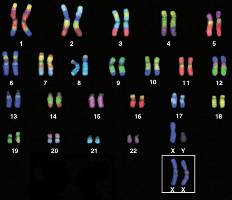Summary
This is an introduction to karyotypes and what uses they have. Prerequisite knowledge would be basic genetic structures, such as chromatids, genes, and alleles. Using this lesson would lead nicely into having a discussion/next lesson about the ethics of gene therapy and CRISPR in humans.
Essential Question(s)
What is the value of genetic testing?
Snapshot
Engage
Students watch a video about a boy with a genetic disorder.
Explore
Students assemble a karyotype in a Card Sort.
Explain
Students learn about karyotypes and the purposes for which they're used.
Extend
Students play the role of a genetic counselor and analyze a karyotype.
Evaluate
Students share their findings to the class.
Materials
Lesson Slides (attached)
Karyotype Card Sort handout (attached; one per pair)
Genetic Counselor Analysis Questions handout (attached)
I Notice, I Wonder handout (attached)
Family Karyotypes document (attached; for teacher use)
Engage
10 Minute(s)
Show the video about Max and his life having a genetic disorder. While students are watching the video, have them use I Notice, I Wonder to jot down observations. Students create a T-Chart (or the included attachment) with one side being I Notice, and the other being I Wonder, and students write down observations and questions as they think of them during the video.
After watching the video, have students casually share a few things they noticed and a few things they wondered.
Explore
10 Minute(s)
Pair students up. Pass out a set of the attached Explore Karyotype Card Sort handout to each pair. Tell the students that there is a full human's set of chromosomes in the envelope. It is their task to organize the chromosome pairs together and decide how to organize the full set.
Explain
10 Minute(s)
After the pairs of students make their card sort, use the included Lesson Slides to ask questions about their reasoning and to show the true answer. Allow students time to compare their karyotype to the formal answer, and to figure out how their reasoning fits with the accepted format.
Once the real answer is posted, ask the students:
Why are there two of each? Answer: one comes from the mother and one comes from the father
Why does the last set go at the end, and not between 4 and 5?
What is the gender of this person?
Finish the conversation with asking the students to I Think/We Think. Individually, ask the students, based on what they've seen, to write out what components need to be included in a karyotype, and what can be determined, or inferred, from a karyotype. After they write on their own, turn to a partner and share their responses together and created a shared vision to use for the next idea.
Extend
15 Minute(s)
For each pair of students, pass out a karyotype for each family, and a copy of the attached Genetic Counselor Analysis Questions handouts. Prompt the students to analyze the karyotypes, and answer the questions as if they are genetic counselors that are about to answer questions that the parents will have. Tell them to be thorough, and as clear as possible.
Evaluate
15 Minute(s)
Have students share their letter with the class. Display each karyotype, either on your own or in the Lesson Slides provided, so the students have something to reference when they share.
Resources
Inspiration for Extend: http://www.ashg.org/education/gena/AdventuresInKaryotyping_L2.pdf
K20 Center. (n.d.). I notice, I wonder. Strategies. https://learn.k20center.ou.edu/strategy/180
K20 Center. (n.d.). I think / we think. Strategies. https://learn.k20center.ou.edu/strategy/141
K20 Center. (n.d.). T-Chart. Strategies. https://learn.k20center.ou.edu/strategy/86


